Life Together in One Heart Chronicle
BULLETIN TABLE OF CONTENTS •
PREVIOUS CHRONICLES
Contemporary scholarship reminds us that Benedict did not "invent" Christian monasticism in the West, nor did he create his monastic vision out of whole cloth. He drew on the riches of monastic communities and tradition which preceded him, arranging the inherited wisdom in a fresh way, and giving it the stamp of his own personality and vision.
Benedict clearly saw himself as part of a larger monastic tradition in the church, both eastern and western, and sought to pass it on freshly in new circumstances.
Both at the beginning of his own Rule for Monks (in the Prologue), and again at the end (in Chapter 73), Benedict recalls the monastic teaching of Saint Basil the Great (330-379 C.E.). He frames his own "little rule for beginners" with references to the spirituality of this great monastic leader of the Eastern Church, and with the encouragement to learn from his writings.
Basil's great passion was the common life: it is only there, he taught, in the ordinary daily life with others, that we have any chance of growing into persons and communities increasingly permeated with the values of the Gospel.
Without others, how do we grow in humility and patience, in solidarity and respect?
Without others with whom we share life, how will we learn to embrace practical service to the neighbor?
As Basil asked so pointedly, "Whose feet will we wash?" How else will we become a living body, breathing together in rhythm with the Breath of the Holy Spirit?
As Christians and as monks, we hope to embrace Basil's challenge -- one which Benedict clearly understood as central to our vocation.
Our daily life with one another is the context for the chronicle of events which follows. Ordinary or special, they form part of the ongoing weaving of a common life, within our community and in communion with all others.
December, 2001
In mid-Advent, we welcomed Franciscan friars from Siena College in Loudonville, New York for a quiet day and exchange with some of our brothers. Shortly before Christmas, two nuns from the Benedictine Abbey of Regina Laudis in Connecticut, Mother Lucia and Mother Thelchilde, joined us for the Sunday Eucharist and a day with our community. We ended the month of December as we welcomed five of our Benedictine sisters from Mexico, who celebrated the feast of Christmas with us.
January 2002
The new year 2002 opened with our winter Experience in Monastic Living, during which a group of young men participated in the daily life of the community and reflected with us on the relevance of monastic values for life today. As always, we are grateful for the generous spirit of each of the participants, who allow us to see the world through their eyes.
January is also the usual time when we reciprocate the December visit of our Mexican Benedictine sisters by traveling to Mexico to share in their common life and ministries. These exchanges continue to deepen our mutual association with the sisters, a community-to-community covenant now over 25 years old. This year, our experiences were centered in Mexico City, where the sisters' Casa Central is located, and in Cuernavaca, the location of the Centro Guadalupe, a retreat center jointly sponsored by our communities. We also enjoyed a day of Eucharist and relaxation with the Benedictine community of the Abbey of Tepeyac, near Mexico City. We thank Abbot Jorge Acuña and all the monks for their warm and generous welcome.
February 2002
In mid-February, Brothers Richard, Placid, and Michael visited the community at the Abbey of Regina Laudis, renewing a friendship reaching back to the earliest days of the priory. Even before the foundation of the priory in Weston, Abbot Leo knew the sisters at Regina Laudis, and served for a time as extraordinary confessor. The sisters welcomed our brothers warmly and joyfully -- even inviting them to join in the dairy for the making of cheese. Once the brothers' cheeses ripened, the sisters sent them for us all to enjoy! Our entire community will spend a day with the nuns in June.
March 2002
The extension of Benedictine hospitality involves the hands and hearts of all the brothers. And, over the years, many other persons have joined with us in the varied tasks of creating a prayerful, safe, and welcoming environment for the many who come to the monastery. Each year, we gather with our co-workers for a weekend retreat, a time in which we give thanks for the love and generosity of so many friends.
On the feast of Saint Joseph, March 19th, the entire community participated in the liturgy during which our good friend, Bishop Paul Bootkoski, was installed as bishop of Metuchen in New Jersey. Bishop Bootkoski has been a friend of the community since his days as a seminary student. We are grateful to have been able to offer him this sign of our brotherly support and prayer as he begins his new ministry as pastor of the local Church of Metuchen.
Interest in monastic spirituality, as inspiration for persons in many walks of life, continues to be a growing phenomenon. The numbers of men and women who spend time at a monastery, sharing in the atmosphere of silence, prayer and work, is one witness to this thirst. In mid-March, students from Regis College in Boston, with two of their professors, spent a day with us, and participated in a discussion on Benedictine monastic life.
April 2002: Walking the Pilgrimage of Emmaus
The days of Easter marked a special kind of beginning for our community -- the inauguration of a series of events with which to celebrate our Jubilee Year. Some of these "events" will be public, welcoming the larger family of friends of the priory. Others will be more "internal," as times of enrichment for the monastic community itself. In all, we hope that, in the time of jubilee, we will renew our commitment to the
vision which has grown and developed in the course of our fifty years, and to deepen our communion with other monastic communities.
As many of you know, our long-standing association with our Mexican Benedictine sisters (spanning more than half of our community history) has also brought us to friendship with a small Benedictine community in South America, the Monastery of the Annunciation of the Lord, in Goiás, Brazil.
Many of the monks from Goiás have spent time with us in Weston, and four of our brothers visited them three years ago. A dream, shared by both communities, was that one day the entire Weston community might experience their life in Brazil.
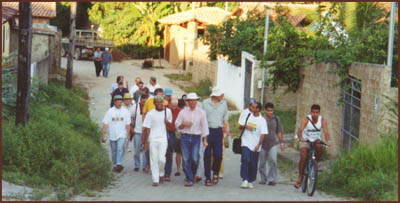
Brothers from Weston and Goiás walking in the poor
neighborhood where the Monastery of the Annunciation
is located.
This dream became reality in April, when the Goiás community began the celebration of their 25th anniversary.
Our journey to Brazil became a fraternal pilgrimage to inaugurate our own communal "Pentecost."
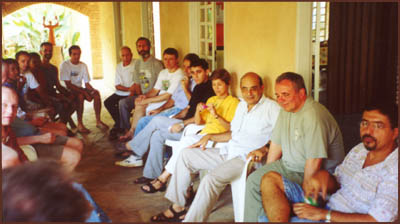
Afternoon meeting of the communities of Weston and Goiás.
Our primary hope was to share in the daily life of the community in Goiás -- in their prayer, work, and outreach -- and to come to know the brothers and sisters there.
The festive paschal liturgies of the Easter season were very nourishing, marked by creativity, joy and participation in dance, song, symbol and gesture.
The common prayer was very Brazilian, yet embracing the entire world, and respectfully open to the riches of other religious traditions.
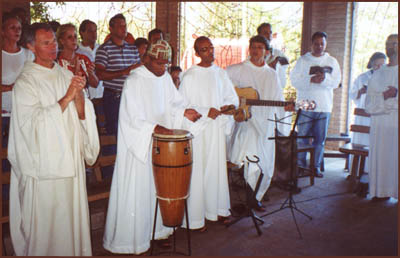
The liturgy in Goiás was very joyful, integrating the gifts
of the Afro-Brazilian culture.
In meetings with the junior monks, in their initial integration, we learned of what led each of them to the monastery in Goiás, and how they envision a monastic community inserted in the world of the poor.
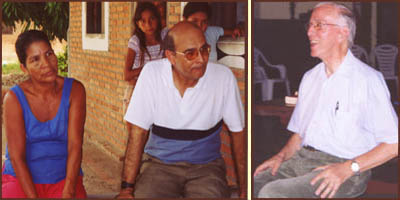
Left: During a visit to an indigenous village on the
Araguaia River: Brother Marcelo and a representative
of the Karajá people. Right: Bishop Pedro Casaldáliga
of Brazil has become pastor to all the Americas because
of his commitment to solidarity with the poorest.
Visits to several other communities enriched our time in Brazil. An experimental center of education, called Vile Esperança, is located directly across the street from the monastery.
Founded by an Argentinean woman (herself a professional dancer and familiar with the Montessori method of education), this small Village of Hope immerses the children in an atmosphere in which respect for indigenous and Afro-Brazilian cultures is inculcated, and in which the entire extended family participates in the education of the young.
One memorable moment was an evening presentation of capoera, a ritual dance form originating with the enslaved Africans brought in chains to Brazil from Angola and surrounding nations. Originally performed in secret, away from the gaze of the European slave-owners, the performance of the capoera was long forbidden by law, since it was a sign of African pride and resistance to slavery.
One of the great pastoral efforts of the Brazilian church, for the last thirty years, has been an organized effort to accompany landless peasants in their struggle to gain access to unused but cultivable land.
Brazilian theologians, including the prior of Goiás, Marcelo Barros, OSB, have written extensively about the God-given rights of all to share in the bounty of the earth.
In the face of fierce opposition from powerful landowners, the Church has continued to accompany the landless poor in their struggle for justice.
Together with the Goiás brothers, we visited an encampment of homeless families who are squatting on land, waiting to receive title to land to cultivate and on which to build their houses. (An accompanying story, "Visions of Hope," tells of our visit to Felicidade.)
A generation ago, landless people, who had no prospect of providing for
their families in the countryside, migrated en masse to the cities in search of work.
The dire economic situation ensured that they would not find work there either; and the attendant social problems accompanying poverty (gangs, drugs, violence) made the situation there increasingly impossible.
One form which the pastoral accompaniment of the landless takes, is to help families return to the countryside, to struggle for title to unused land, and to educate a new generation in farming skills and animal husbandry.
We visited one such center of education, Escola Agricola, initiated by the late Filipe Leddet, OSB, one of the founding members of the Goiás monastery.
There, young people come for two weeks of intensive studies in their normal academic subjects, combined with hands-on learning of organic farming methods. The students return to their villages for two weeks, putting into practice what they have studied, and then come again to the school for another two weeks -- in a year-round cycle of education and practice.
Our days with the brothers and sisters of Goiás were a space of communion, in which we were enabled to deepen our evangelical solidarity in the church, in the monastic family, and in the world.
The monastery in Goiás is a foundation of the Benedictine Abbey of Tournay in southern France -- and we were privileged that the young abbot of Tournay, Abbot Joël Chauvelot, visited Goiás during our time there. With Abbot Joël's presence, many of our meetings took on an even more universal hue, as we conversed (with translation!) in Portuguese, French, Spanish, and English.
The great bishop of the poor, Pedro Casaldáliga, of the diocese of Sao Felix in the Amazon, came to the monastery for a visit. Now nearly seventy-five years old, he has been a ceaseless defender of the rights of the indigenous people of the Americas. What marveled us was his sense of genuine hope for
the Church, in an epoch marked by so much discouragement and retrenchment.
Nothing can permanently reverse the great opening of the Holy Spirit at the Second Vatican Council, he said, and the ways in which lay Christians have made their own the vision of a renewed and humble Church.
As one who has suffered for his commitment to the poor and to the legacy of Pope John XXIII, his words of hope have authority for us, and are a mandate that we continue to work for the Church's renewal in faithfulness and service, and for solidarity with the poor of the world.
For the opening celebration of the 25th anniversary of the foundation of the monastery of the Annunciation in Goiás, the diocesan bishop, Dom Eugenio, participated in the Saturday evening Vigil of the Resurrection.
At that celebration, two of the monks, Brother Patrick and Brother André, made their first monastic profession.
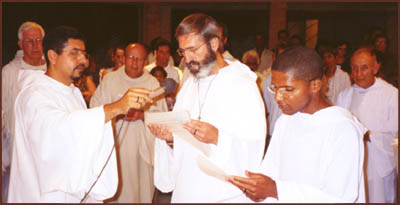
The first monastic profession of Brothers André
and Patrick as monks of Goiás.
One of our Mexican Benedictine sisters serving in Brazil, Sister Rosa González, OSB, came to the monastery for the weekend celebrations. On the following day, the former bishop, Dom Tomás Balduino, OP, presided at the eucharistic celebration.
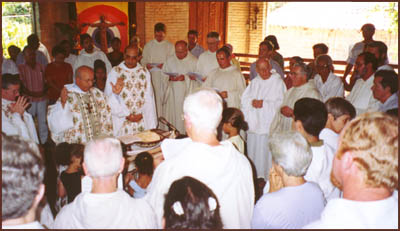
Bishop Tomás Balduino leads the assembly in the
Eucharistic Prayer. Next to him are Abbot Joël of
Tournay (left) and brother Marcelo of Goiás (right).
Together with Dom Pedro Casaldáliga, Dom Tomás has been one of Brazil's staunchest defenders of human rights. In his "retirement," he continues to serve the church in its pastoral accompaniment of the landless poor.
The land on which the Monastery of the Annunciation in Goiás is built was a gift to the first brothers from a community of Dominican sisters, who maintain a home for mentally and developmentally challenged persons in Goiás.
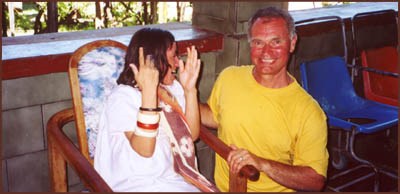
The joy is palpable on the faces of Brother Placid and
a young resident of the Asilo of Saint Vincent de Paul.
The Asilo, dedicated to Saint Vincent de Paul, is located adjacent to the monastery. Most of the residents, ranging in age from their mid-teens to their eighties, have been abandoned by their families. We spent a morning with the residents at the Center, and were profoundly moved by the commitment to offer a place of dignity, love, and respect to these poorest of the poor. On our last evening in Goiás, residents of the Asilo, joined together with students and faculty from the Vila Esperança in presenting a program of Therapeutic Dance in the monastery church.
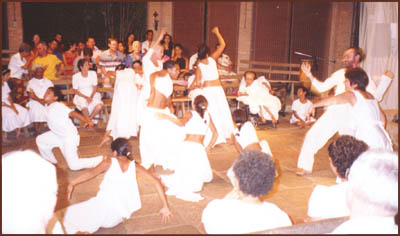
Residents from the Asilo, together with students and staff
from the Vila Esperança, are one in the joy of dancing together.
The commentary opening the presentation stated that, in a world of divisions and barriers, we long for a world where the walls have fallen and all are free. As the residents (many
physically handicapped, some in wheelchairs, or seated on the floor) and their helpers entered into the free gestures of the dances, their bodies moved with a gracefulness and joy that was beyond verbal expression.
For all of us, the experience was a sacrament, an embodiment of the Reign of God -- this is how our God dances with us, leading all of us beyond our limitations and brokenness, creating a harmony where each person is uniquely her- or himself, and we are drawn into a beauty greater than all of us.
May 2002
In May, we welcomed Abbot Notker Wolf, the abbot primate of the Benedictine Confederation, for a short visit.
|
Living at the Abbey of Sant'Anselmo in Rome, his ministry as abbot primate is meant to facilitate communion among Benedictine communities worldwide, and to represent the interests and charisms of the Benedictine Confederation to the larger church. He has a special concern for emerging monasteries in the developing world. Abbot Notker had planned to visit us in September of last year, but his plans were suspended by the terrible events of September 11th.
|
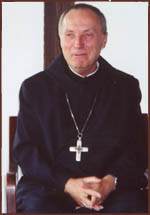
Abbot Primate
Notker Wolf, OSB
|
We were pleased to welcome him this spring.
On Saturday, May 18th, the Vigil of Pentecost, we welcomed Brother
Iain Highet as a postulant in our community. Brother Iain, originally from Canada, has served as an environmental consultant to the Benedictine nuns of the Abbey of Regina Laudis in Connecticut. We pray for the accompaniment of God's Spirit, as we begin this new step of discernment together that our friendship may grow into brotherhood.

